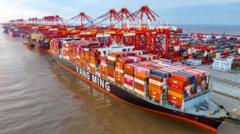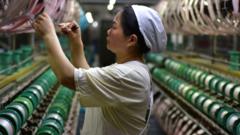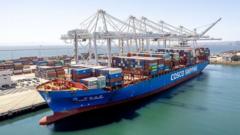As Donald Trump re-enters the political arena, uncertainties about tariffs and economic policies loom large, influencing growth forecasts, trade relations, and inflation dynamics worldwide.
**Trump 2.0: A Shifting Paradigm for Global Economics in 2025**

**Trump 2.0: A Shifting Paradigm for Global Economics in 2025**
Will new tariffs under a Trump administration impact global growth and inflation?
The global economy is bracing for a transformative year ahead, particularly as the potential reintroduction of Trump's economic policies could redefine trade dynamics and inflation management. According to the International Monetary Fund (IMF), growth in 2025 is expected to stabilize around a subdued 3.2%. December brought a respite for American borrowers with an interest rate cut, marking the third consecutive reduction. However, the stock market reacted negatively when US Federal Reserve Chair Jerome Powell signaled a cautious approach to future cuts as the battle against inflation persists.
Recent inflationary trends have caused increases in the US, eurozone, and UK, with rates settling at 2.7%, 2.2%, and 2.6%, respectively. This speaks to the ongoing challenges central banks face as they strive to reach their targets. Economic uncertainties, particularly stemming from Trump's potential policies, are central to the risks confronting global growth. Luis Oganes, head of global macro research at JP Morgan, asserts that the potential return to an isolationist stance and new tariffs poses significant risks to countries reliant on trade with the US.
The looming threat of tariffs is concerning for Canada and Mexico, two critical trading partners in the US manufacturing ecosystem. Maurice Obstfeld, a former chief economist at the IMF, highlights the detrimental impact tariffs could have on industries like automotive manufacturing, which depend on integrated supply chains. Disruptions could lead to increased costs, lower demand, and diminished company profits, fostering a cycle of reduced investment.
As Donald Trump continues to hint at new tariffs, especially against China, the global second-largest economy braces for impact. President Xi Jinping noted the "uncertainties in the environment," emphasizing the importance of exports which could dwindle if tariffs raise prices. The World Bank has adjusted China's growth forecasts upwards, indicating a reliance on strong domestic recovery to mitigate the risks posed by potential tariffs.
In Europe, the ramifications of US tariffs are causing considerable concern. Christine Lagarde, president of the European Central Bank, warned that trade restrictions could stifle economic growth and exacerbate inflation's unpredictability. The eurozone's performance has been underwhelming, chiefly due to internal political strains and inflationary pressures that threaten consumer spending.
In the UK, the economic landscape could shift as wage and tax increases loom on the horizon, adding to existing inflation challenges, which hover around 4.2%. Corporate wage pressures are expected to persist, furthering inflation as businesses aim to offload rising costs onto consumers.
As Trump prepares for a possible presidency, the spotlight remains on his economic strategies that promise tax cuts and deregulation. Although specifics may remain vague until his return to office, the overarching narrative points toward a future marked by US economic dominance at the risk of global upheaval. As the world watches closely, the effectiveness of upcoming policies, especially those from the US, will be crucial in assessing building global economic dynamics moving forward.
Recent inflationary trends have caused increases in the US, eurozone, and UK, with rates settling at 2.7%, 2.2%, and 2.6%, respectively. This speaks to the ongoing challenges central banks face as they strive to reach their targets. Economic uncertainties, particularly stemming from Trump's potential policies, are central to the risks confronting global growth. Luis Oganes, head of global macro research at JP Morgan, asserts that the potential return to an isolationist stance and new tariffs poses significant risks to countries reliant on trade with the US.
The looming threat of tariffs is concerning for Canada and Mexico, two critical trading partners in the US manufacturing ecosystem. Maurice Obstfeld, a former chief economist at the IMF, highlights the detrimental impact tariffs could have on industries like automotive manufacturing, which depend on integrated supply chains. Disruptions could lead to increased costs, lower demand, and diminished company profits, fostering a cycle of reduced investment.
As Donald Trump continues to hint at new tariffs, especially against China, the global second-largest economy braces for impact. President Xi Jinping noted the "uncertainties in the environment," emphasizing the importance of exports which could dwindle if tariffs raise prices. The World Bank has adjusted China's growth forecasts upwards, indicating a reliance on strong domestic recovery to mitigate the risks posed by potential tariffs.
In Europe, the ramifications of US tariffs are causing considerable concern. Christine Lagarde, president of the European Central Bank, warned that trade restrictions could stifle economic growth and exacerbate inflation's unpredictability. The eurozone's performance has been underwhelming, chiefly due to internal political strains and inflationary pressures that threaten consumer spending.
In the UK, the economic landscape could shift as wage and tax increases loom on the horizon, adding to existing inflation challenges, which hover around 4.2%. Corporate wage pressures are expected to persist, furthering inflation as businesses aim to offload rising costs onto consumers.
As Trump prepares for a possible presidency, the spotlight remains on his economic strategies that promise tax cuts and deregulation. Although specifics may remain vague until his return to office, the overarching narrative points toward a future marked by US economic dominance at the risk of global upheaval. As the world watches closely, the effectiveness of upcoming policies, especially those from the US, will be crucial in assessing building global economic dynamics moving forward.






















